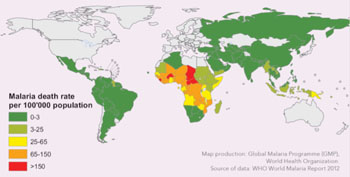Imminent Danger of Drug-Resistant Malaria Spreading from Myanmar
By LabMedica International staff writers
Posted on 03 Mar 2015
Resistance of the malaria parasite P. falciparum to artemisinin has been spreading and is on the verge of entering India, according to a new study.Posted on 03 Mar 2015
Researchers at Mahidol University (Bangkok, Thailand), the Defence Services Medical Research Center (Naypyitaw, Myanmar), the Texas Biomedical Research Institute (San Antonio, TX, USA), Oxford University (United Kingdom), and other institutions conducted a cross-sectional survey at 55 malaria treatment centers in Myanmar, as well as in relevant border regions in Thailand and Bangladesh, to assess the spread of artemisinin-resistant P. falciparum by determining the relative prevalence of parasites carrying K13-propeller mutations.

Image: Global malaria death rates (Photo courtesy of the WHO Global Malaria Program).
The researchers then used two geostatistical models to produce predictive maps of the estimated prevalence of mutations region across Myanmar. They found that 39% of the samples carried 26 different K13-propeller mutations, including 9 mutations not previously described in Southeast Asia. In 70% of the administrative regions of Myanmar, the combined K13-mutation prevalence was more than 20%. In Homalin (Sagaing Region), which is just 25 km from the Indian border, 47% of 45 parasite samples carried mutations. The study was published in the February 2015 issue of Lancet Infectious Diseases.
“Myanmar is considered the frontline in the battle against artemisinin resistance as it forms a gateway for resistance to spread to the rest of the world,” said Charles Woodrow, MD, of the Mahidol-Oxford Tropical Medicine Research Unit. “With artemisinins we are in the unusual position of having molecular markers for resistance before resistance has spread globally. The more we understand about the current situation in the border regions, the better prepared we are to adapt and implement strategies to overcome the spread of further drug resistance.”
“Drug-resistant malaria parasites in the 1960’s originated in Southeast Asia, and from there spread through Myanmar to India and then to the rest of the world, where it killed millions of people,” said Prof. Mike Turner, PhD, head of infection and immunobiology at the Wellcome Trust (London, United Kingdom). “The new research shows that history is repeating itself with parasites resistant to artemisinin drugs, the mainstay of modern malaria treatment, now widespread in Myanmar. We are facing the imminent threat of resistance spreading into India, with thousands of lives at risk.”
Artemisinin-based combination therapies were introduced in the mid-1990s, when there was an imminent prospect of untreatable malaria in Southeast Asia, where resistance to all available antimalarial drugs had developed. History could be repeating itself; while chloroquine probably saved hundreds of millions of lives, resistance was discovered in 1957 around the border between Cambodia and Thailand, reaching Africa 17 years later.
Related Links:
Mahidol University
Texas Biomedical Research Institute
Oxford University













